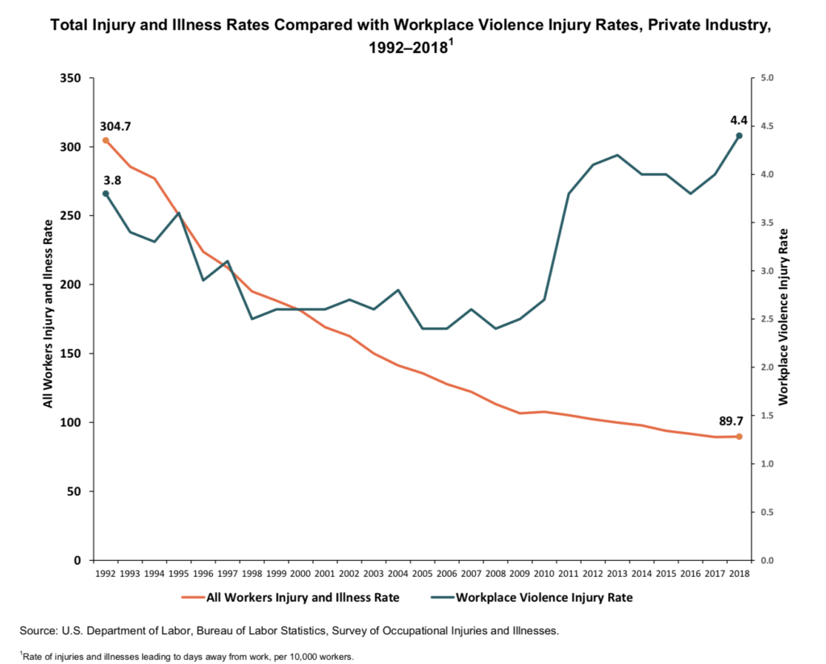The true scope of workplace violence is currently unknown. This is especially the case with pandemic-related workplace violence. But we are seeing alarming indicators. In a recent episode of Employment Law This Week Attorney Beth McManus (Senior Counsel in the Employment, Labor & Workforce Management division of Epstein Becker Green) explained, “the stresses and conflicts caused by COVID-19, often related to either mask wearing or social distancing guidelines, we’ve seen [increased] instances of violence in the workplace, often against employees working in retail settings.”
Greg Murphy, head of loss prevention at United Pacific, is far from surprised. He noted an uptick in workplace violence targeting employees beginning very early in the pandemic, around February 2020. Recent data is pointed towards the coronavirus showing no signs of falling back anytime soon. And for retail and other essential workplaces, it’s time to make changes to protect workers.
Changing Behavior Means Adjusting Policies
Murphy recently spoke at the National Retail Federation’s annual NRF Protect All Access event (held virtually). There, he addressed the new challenges that pandemic-driven social changes have brought to de-escalation in the workplace. He specifically noted broad trends, with many businesses in many locations reporting an increase in verbal altercations and violence. These often started as mask disputes and ended with physical blows or “frustration-related vandalism” (e.g., slammed doors, smashed products, and trashing registers or fixtures).
Murphy noted that United Pacific has a long track record of using technology and physical barrier systems to mitigate threats to employee safety. “Technology is replaceable,” Murphy noted. “Human life is not.”
But solutions don’t need to be technological—or even represent a new investment. Hugo Cortez, Field Security Manager for Global Safety, Security, & Intelligence at McDonald’s Corporation spoke alongside Murphy at NRF Protect All Access and shared details of an in-store assault, caught on security camera, that began when an employee approached a guest who was not wearing a mask.
Had the employee done anything wrong? Not at all. But we are in new territory and these are important learning opportunities for businesses. Issues around the pandemic have become incredibly emotionally charged, and cannot be approached casually. Cortez and his team used this and other similar events to re-evaluate how employees approach non-mask wearers. They developed a better set of protocols to protect worker safety. For example, today McDonald’s employees are advised to address mask issues from behind the counter. They take advantage of the natural barrier and increased distance that this physical obstacle creates.
“This is a good example of a smart adaptation,” notes Total Security Solutions CEO Jim Richards. “A very small behavioral change—taking advantage of a barrier you already have in place—can really mitigate a lot of potential risk.”
Learn all about The 8 Levels of Bullet-Resistant Security Glass
An Age of Workplace Violence
Jim is always quick to point out that the pandemic-related workplace violence we’re seeing now is not just the result of pandemic frustrations boiling over. These pandemic-related incidents need to be understood against a years-long backdrop of increasing workplace violence. According to the 29th edition of the AFL-CIO’s annual report Death on the Job: The Toll of Neglect, “[w]orkplace violence is a growing and serious threat, particularly to women workers.”
The AFL-CIO report was released just last month but focuses primarily on conditions as of 2018. (That is the most recent year for which complete numbers are available, and more than 18 months before the pandemic began.) In the report, the authors highlight a decade-long trend, during which worker injuries and illness fell overall, but the proportion of injuries attributed to violence climbed alarmingly: “Workplace violence deaths … are now the second-leading cause of job death.”

Trends in U.S. workplace violence and injury (source: AFL-CIO’s 29th annual “Death on the Job: The Toll of Neglect” report)
They report that “Workplace violence remains a serious and growing problem “… Workplace violence deaths increased to 828 in 2018, and violence-related injuries increased to more than 30,000 lost-time injuries.”
More than half (453) of those 828 violent deaths were ruled homicides.
“Women workers are at greater risk of violence than men; they suffered two-thirds of the lost-time injuries related to workplace violence.”
Workplace Violence Isn’t Just Customers Lashing Out
Attorney Beth McManus notes that COVID stresses aren’t just driving an increase in altercations among customers or between customers and workers.
“What we’re also seeing is an increase in inter-employee tensions over social distancing practices or differing attitudes related to the virus.”
As she explains, “An important starting place for safeguarding the workplace against instances of workplace violence begins with a strong and well-drafted workplace violence prevention policy. … Also employers should prepare an emergency safety plan for worst-case scenarios so that employees are aware of what to do if there is an actual or imminent threat of physical violence—when to call the police, where the nearest exits are.” TSS has found that revisiting emergency, evacuation, and active attacker plans are especially important during the pandemic. Most businesses have had to rearrange their physical space in order to keep doing business. This may complicate (or even derail) the evacuation and escape routes employees are familiar with. Review your training and plans; walk through each procedure. Are there new impediments? Can those be mitigated or does the procedure need to change?
According to United Pacific’s Greg Murphy, one of the most important interventions is equally beneficial—regardless of whether the potential assailant is a coworker, customer, or random person off the street—as well as cheap:
Treat all assaults as assaults. Almost every workplace assault begins with verbal violence.
“Don’t wait around for the verbal assault to escalate to a physical assault,” Murphy advises.


